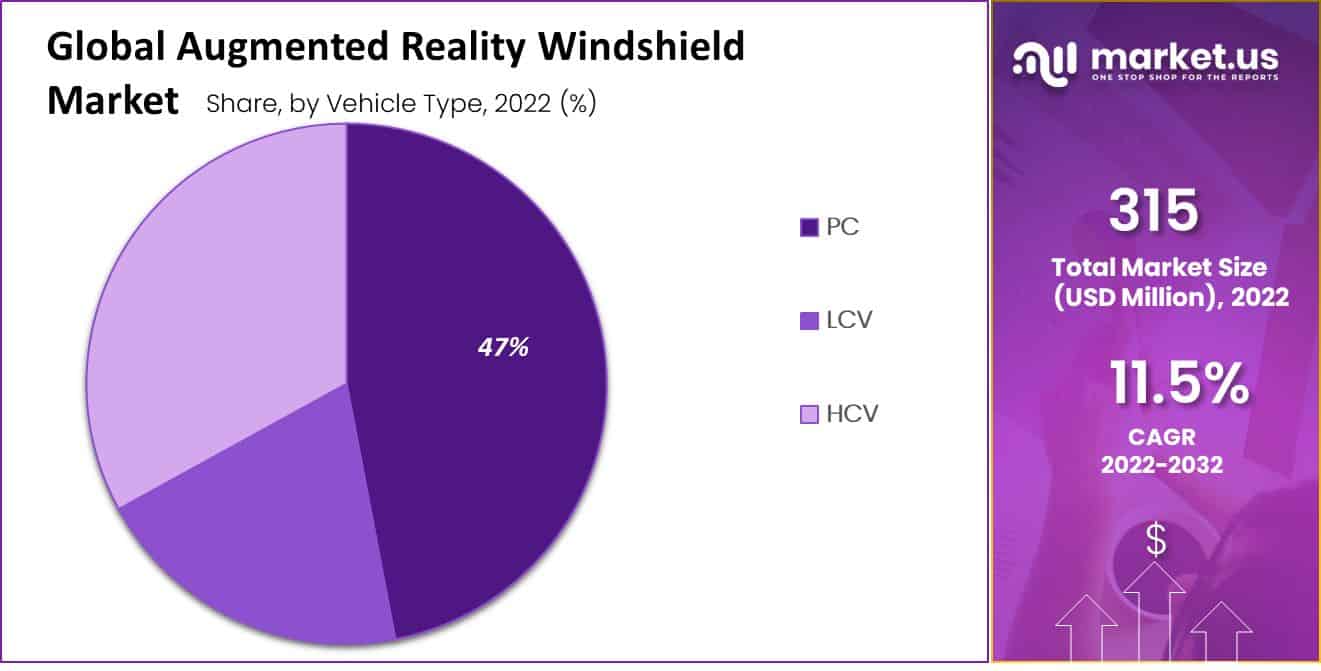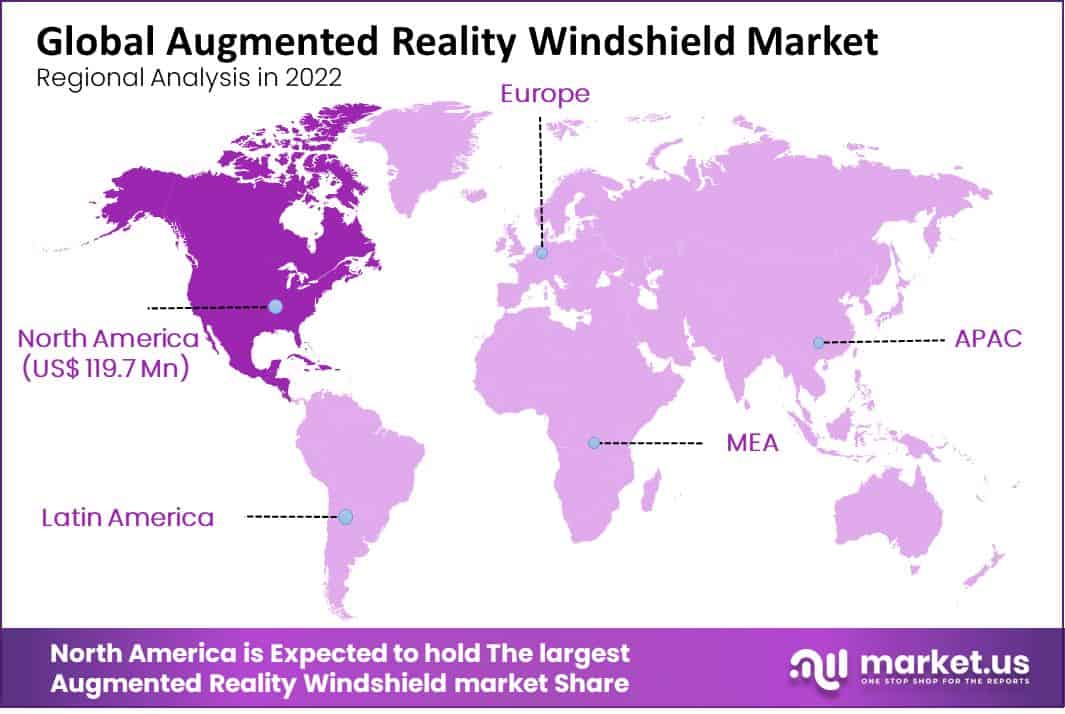Global Augmented Reality Windshield Market By Position Type (Front and Rare), By Vehicle Type (PC, LCV, and HCV), By Region and Companies - Industry Segment Outlook, Market Assessment, Competition Scenario, Trends, and Forecast 2023-2032
- Published date: Sep 2023
- Report ID: 99477
- Number of Pages: 350
- Format:
- keyboard_arrow_up
Quick Navigation
Report Overview
The Global Augmented Reality Windshield Market size is expected to be worth around USD 910.00 Billion by 2032 from USD 315 Billion in 2022, growing at a CAGR of 11.50% during the forecast period from 2023 to 2032.
The market for augmented reality windshields is expanding in the car sector. It entails using augmented reality technology to project data onto a car’s windshield, including speed, navigation, and other driving assistance tools.
The demand for sophisticated safety features in automobiles is on the rise, and connected cars are becoming more and more common, which is fueling the market for augmented-reality windshields. Additionally, the growing use of electric cars is anticipated to further support market expansion.

Driving Factors
Rising Demand for Connected Cars: As connected cars become more common, demand for augmented reality windshields is expected to soar due to cutting-edge technologies like 5G connectivity, artificial intelligence, and the Internet of Things (IoT). These intuitive interfaces enable drivers to interact with their cars in new ways, offering them a better driving experience.
Growing focus on road safety: As driver safety becomes a more pressing concern, particularly in light of rising accident rates and the adoption of autonomous driving technologies, augmented reality windshields are seen as a promising solution. Real-time data on the environment, traffic, and potential dangers on the road can aid drivers in making more informed decisions.
Advancements in display technologies: It is becoming simpler to incorporate augmented reality features into windshields without obstructing the driver’s view thanks to the creation of new display technologies like holographic displays and transparent OLED displays. The usage of augmented reality windshields is anticipated to increase as a result in the upcoming years.
Increasing demand for luxury vehicles: Currently, augmented reality windshields are available in high-end luxury vehicles, which are experiencing increasing demand in emerging markets such as China and India. The demand for augmented reality windshields is anticipated to increase alongside the market for luxury cars.
Restraining Factors
High price: Because these windshields are challenging to make, their high price may prevent their widespread use. This is particularly true for lower-end vehicle classes like economy cars, where cost is an important factor.
Safety Concern: Although augmented reality windshields can provide drivers with real-time information, there is a risk that having too much information will make drivers distracted and jeopardize road safety. When using subpar interfaces or displays, this is particularly problematic.
Growth Opportunities
The automotive sector presents one of the biggest possibilities for the Augmented Reality Windshield Market, as AR technology can be applied to increase driver safety and boost vehicle performance. Drivers can make better choices while driving by having access to real-time information from AR windshields about the state of the roads, traffic patterns, and weather.
By giving drivers more precise and timely information, AR technology can also be used to improve driving assistance systems like lane departure warnings and adaptive cruise control. The Augmented Reality Windshield Market has possibilities outside of the automotive sector as well, including in the military and aviation sectors. The use of AR technology in military vehicles and aircraft can both increase situational awareness and decision-making in combat situations.
Latest Trends
Recently, as technology has progressed and become more widely adopted, several trends have emerged in the Augmented Reality Windshield Market. Utilizing advanced sensors and cameras enables systems to gather and analyze more data in real-time, which is one of the major trends within the Augmented Reality Windshield Market. As a result, drivers receive more precise knowledge about their environment based on this collected information.
Another trend seen in the market for AR windshields is the creation of more logical and user-friendly interfaces. While recent improvements to interface design have made it simpler for drivers to access and interact with information provided by their AR windshields, AR technology can still prove confusing or challenging to master.
The commercial and industrial sectors, where AR technology can be used to boost worker productivity and safety, are also embracing the Augmented Reality Windshield Market more and more. For instance, AR windshields in construction vehicles can give employees up-to-the-minute information about their surroundings, allowing them to work more securely and productively.
Position Type Analysis
Based on position type, the market for augmented reality windshields is segmented into front and rear. Among these types, the front segment is dominant in the market with a 74% market share. The front position version of an augmented reality windshield is mounted in the front of the car, usually in the driver’s line of sight, and shows data like speed, navigation, and traffic hazards.
Without taking their eyes off the road, it enables the driver to remain informed about the state of the road. The rear position type of an AR windshield is placed in the back of the car and shows data like the rearview camera feed, the separation between the car and other objects, and parking assistance. It enhances the driver’s situational awareness while reversing and aids in navigating through confined areas.
Vehicle Type Analysis
On the basis of vehicle types, the market for an augmented reality windshield is segmented into PC (Passenger Car), LCV (Light Commercial Vehicle), and HCV (Heavy Commercial Vehicle). The type of vehicle which have augmented reality in their windshield in major amount is PC.
To passenger cars, augmented reality helps to display information such as navigation directions, traffic alerts, and hazard warnings, and also provides a virtual overlay of the road ahead to assist with lane guidance.
In LCV the windshield can display information such as the vehicle’s speed and location, as well as provide a virtual overlay of the road ahead to assist with navigation and obstacle avoidance. In HCV vehicles augmented reality windshield has the role of protecting the driver’s safety and reducing fatigue during long drives.

Key Market Segments
Based on Position Type
- Front
- Rear
Based on Vehicle Type
- PC
- LCV
- HCV
COVID-19 Impact Analysis
The COVID-19 pandemic has had a profound effect on the Augmented Reality Windshield Market, amplifying some existing trends while disrupting others. One of the most noticeable outcomes has been an uptick in demand for contactless and touchless technologies – such as AR windshields – as drivers seek to minimize physical contact with their vehicles. This has further encouraged demand for intuitive and user-friendly interfaces in AR windshields due to drivers’ desire to reduce physical contact.
The pandemic has also disrupted supply chains and manufacturing processes, leading to delays in product launches and a slowdown in innovation. Nevertheless, the market has adjusted by developing retrofit kits that can be installed on existing vehicles rather than creating new products with more complex manufacturing procedures.
Another effect of the pandemic has been an increased inclination towards remote work and online collaboration, leading to greater adoption of AR technology outside of automotive and military fields. For instance, AR Windshields can be utilized in remote maintenance and repair applications, enabling technicians to offer support over distance rather than needing on-site visits.
Regional Analysis
The market for augmented reality windshields is expanding and innovating in various areas, with unique trends appearing in each. With a 38% market share, North America dominates the other areas. Advanced driver assistance systems (ADAS) and a growing interest in autonomous vehicles are driving demand in this area, resulting in the integration of more advanced sensors and cameras into AR Windshield systems so drivers can receive accurate information more quickly.
Europe has placed increasing emphasis on ecology and reducing carbon emissions. To this end, fuel-efficient AR windshield systems have been created that can save fuel consumption and boost vehicle efficiency.
Furthermore, growing electric vehicle adoption and demand for advanced safety features are propelling the market in APAC with user-friendly interfaces and cutting-edge sensor technologies to enhance driving performance and safety. Middle Eastern investors are driving demand in AR windshield systems across building & industry, commercial trucks & public transportation vehicles alike – spurring investments into infrastructure projects.

Key Regions and Countries Covered in this Report:
- North America
- The US
- Canada
- Mexico
- Western Europe
- Germany
- France
- The UK
- Spain
- Italy
- Portugal
- Ireland
- Austria
- Switzerland
- Benelux
- Nordic
- Rest of Western Europe
- Eastern Europe
- Russia
- Poland
- The Czech Republic
- Greece
- Rest of Eastern Europe
- APAC
- China
- Japan
- South Korea
- India
- Australia & New Zealand
- Indonesia
- Malaysia
- Philippines
- Singapore
- Thailand
- Vietnam
- Rest of APAC
- Latin America
- Brazil
- Colombia
- Chile
- Argentina
- Costa Rica
- Rest of Latin America
- Middle East & Africa
- Algeria
- Egypt
- Israel
- Kuwait
- Nigeria
- Saudi Arabia
- South Africa
- Turkey
- United Arab Emirates
- Rest of MEA
The market for augmented reality (AR) windshields is still developing and has several major players competing for market dominance. It is anticipated that key players will continue to invest in this developing market while heavily involved in the research and development of AR Windshield technology. As the market expands, we can anticipate more rivalry and innovation from both existing players and recent entrants.
Market Key Players:
Listed below are some of the most prominent augmented reality windshield industry players
- AGC Inc
- Compagnie de Saint-Gobain
- Magna International
- Xinyi Glass Holdings Limited
- Fuyao Glass Industry Group Co Ltd
- Shenzhen Benson Automobile Glass Co Ltd
- Dura Automotive Systems Inc
- Niantic
- Scanta
- Other Key Players
Recent Developments:
- In February 2021: Two companies Continental and DigiLens made a partnership. DigiLens is a leader in holographic waveguide display technology. They make partnerships for developing augmented reality windshield solutions that provide drivers with a more immersive and instinctive demonstration of real-time information.
- In October 2021: Jaguar Land Rover launches clear sight augmented windshield reality. This system makes use of sensors and cameras which give information about the road in front of them, and improve visibility in poor weather and weakly illuminated areas.
Report Scope:
Report Features Description Market Value (2022) US$ 315 Mn Forecast Revenue (2032) US$ 910 Mn CAGR (2023-2032) 11.5% Base Year for Estimation 2022 Historic Period 2016-2022 Forecast Period 2023-2032 Report Coverage Revenue Forecast, Market Dynamics, COVID-19 Impact, Competitive Landscape, Recent Developments Segments Covered By Position Type-Front and Rare; By Vehicle Type-PC, LCV, and HCV Regional Analysis North America – The US, Canada, & Mexico; Western Europe – Germany, France, The UK, Spain, Italy, Portugal, Ireland, Austria, Switzerland, Benelux, Nordic, & Rest of Western Europe; Eastern Europe – Russia, Poland, The Czech Republic, Greece, & Rest of Eastern Europe; APAC – China, Japan, South Korea, India, Australia & New Zealand, Indonesia, Malaysia, Philippines, Singapore, Thailand, Vietnam, & Rest of APAC; Latin America – Brazil, Colombia, Chile, Argentina, Costa Rica, & Rest of Latin America; the Middle East & Africa – Algeria, Egypt, Israel, Kuwait, Nigeria, Saudi Arabia, South Africa, Turkey, United Arab Emirates, & Rest of MEA Competitive Landscape AGC Inc, Compagnie de Saint-Gobain, Magna International, Xinyi Glass Holdings Limited, Fuyao Glass Industry Group Co Ltd, Shenzhen Benson Automobile Glass Co Ltd, Dura Automotive Systems Inc, Niantic, Scanta, and Other Key Players Customization Scope Customization for segments, region/country-level will be provided. Moreover, additional customization can be done based on the requirements. Purchase Options We have three licenses to opt for Single User License, Multi-User License (Up to 5 Users), Corporate Use License (Unlimited User and Printable PDF) Frequently Asked Questions (FAQ)
What is the Augmented Reality Windshield Market Size in the Year 2022?The Global Augmented Reality Windshield Market size was USD 315 Billion in 2022, growing at a CAGR of 11.50%.
What is the Augmented Reality Windshield Market CAGR Estimated During the Forecast Period?The Global Augmented Reality Windshield Market size is expected to grow at a CAGR of 11.50% during the forecast period from 2023 to 2032.
What is the Augmented Reality Windshield Market Size Estimated During the Forecast Period?The Global Augmented Reality Windshield Market size is expected to be worth around USD 910.00 Billion by 2032 during the forecast period.
 Augmented Reality Windshield MarketPublished date: Sep 2023add_shopping_cartBuy Now get_appDownload Sample
Augmented Reality Windshield MarketPublished date: Sep 2023add_shopping_cartBuy Now get_appDownload Sample - AGC Inc. Company Profile
- Compagnie de Saint-Gobain
- Magna International
- Xinyi Glass Holdings Limited
- Fuyao Glass Industry Group Co Ltd
- Shenzhen Benson Automobile Glass Co Ltd
- Dura Automotive Systems Inc
- Niantic
- Scanta
- Other Key Players
- settingsSettings
Our Clients
| Single User $4,599 $3,499 USD / per unit save 24% | Multi User $5,999 $4,299 USD / per unit save 28% | Corporate User $7,299 $4,999 USD / per unit save 32% | |
|---|---|---|---|
| e-Access | |||
| Report Library Access | |||
| Data Set (Excel) | |||
| Company Profile Library Access | |||
| Interactive Dashboard | |||
| Free Custumization | No | up to 10 hrs work | up to 30 hrs work |
| Accessibility | 1 User | 2-5 User | Unlimited |
| Analyst Support | up to 20 hrs | up to 40 hrs | up to 50 hrs |
| Benefit | Up to 20% off on next purchase | Up to 25% off on next purchase | Up to 30% off on next purchase |
| Buy Now ($ 3,499) | Buy Now ($ 4,299) | Buy Now ($ 4,999) |












